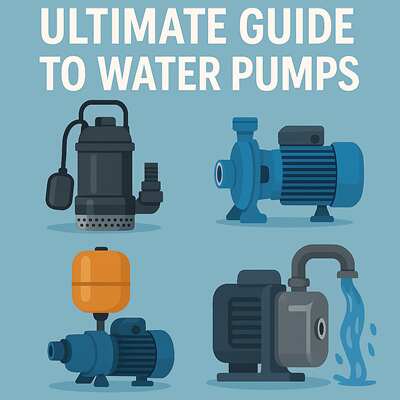Ultimate Guide to Water Pumps: Types (submersible, centrifugal, booster, well) & How to Choose
Choosing a water pump can feel like decoding a secret manual: tons of jargon, a shelf of model numbers, and a dozen ways things can go wrong. Relax, this guide cuts through the static. Below you will find the main pump types, what they actually do, and a practical checklist to choose the right pump for your home, well, pond, or project.

Why pump selection matters
A wrong pump wastes money, underperforms, and shortens service life. The right one delivers steady water pressure, quiet operation, and reasonable energy use. Whether you need a sump pump for a basement, a submersible well pump for a rural house, or a booster pump for weak mains pressure, understanding application, flow, and head will save headaches.
Common pump types, explained
Submersible pump
Sits underwater, usually inside a sump pit or well casing. Ideal for basements, sewage removal, and deep well extraction. Advantages: quiet, priming not required, good for debris when designed as a trash pump. Watch for seals and motor cooling.
Centrifugal pump
Surface mounted, uses an impeller to push water outward. Very common for irrigation, water transfer, and small pressure systems. They are simple, relatively inexpensive, and easy to service, but need priming unless they are self priming models.
Booster pump
Used to raise water pressure for showers, irrigation, or long runs where mains pressure is weak. Can be inline or coupled to a pressure tank and switch for smoother delivery. Great fix for low pressure taps without replacing entire plumbing.
Well pump (shallow vs deep)
Shallow well pumps sit above ground and draw from depths up to ~25 feet. Deep well pumps are typically submersible and designed for wells dozens to hundreds of feet deep. Choose based on well depth and required flow.
Specialty pumps you’ll see often
- Sump pump for basement flooding prevention.
- Trash pump for muddy, debris laden water at construction sites.
- Pond and fountain pumps for circulation and aesthetics.
- Solar powered pumps and 12V water pumps for off grid or remote installations.
- Hand pump when power is unavailable or for emergency wells.
- Hot water recirculating pump and pressure washer pump are niche but common in household systems and cleaning gear.
How to choose: the practical checklist
Use this checklist like a grocery list: tick boxes, don’t guess.
1. Define the job
What are you pumping? Clean water, greywater, slurry, or sewage? Is it for household supply, irrigation, or drainage? If it’s for a basement, you probably want a sump pump. For a well, identify depth.
2. Flow rate and head
Flow is measured in GPM (gallons per minute) or L/min. Head is the vertical height water must be lifted, measured in feet or meters. Pumps are rated for performance curves; match required GPM at the total head. If unsure, oversize slightly rather than undersize.
3. Power source
Electric is common and efficient. For remote sites consider solar or battery powered (12V) units. Diesel or gas may be used for very large transfer pumps. Remember: availability of reliable electricity shapes choices.
4. Materials and build
Stainless steel, bronze, or cast iron matters for longevity and corrosion resistance. For seawater or corrosive conditions pick corrosion resistant materials.
5. Installation constraints
Space, noise tolerance, and accessibility for maintenance. Submersible pumps keep the noise down but complicate retrieval. Surface pumps are easier to service but require priming and shelter from weather.
6. Pressure control
If you need constant pressure for a house, pair the pump with a water pressure tank and pressure switch; for variable demand choose a variable speed drive or inverter ready pump.
7. Maintenance and spare parts
Look for pumps with available seals, impellers, and motors. Brands that local plumbers stock are easier to service. Avoid exotic electronics if you want simplicity.
8. Budget and lifecycle cost
Purchase price is only part of the story. Energy consumption, expected repair intervals, and service life matter. A cheap electric pump that guzzles electricity will cost more over time.
Installation tips and gotchas
- Priming: Many centrifugal pumps need priming; don’t assume self priming.
- Check valves: Install one way valves to prevent backflow and pump cycling.
- Proper sizing: Oversized pipework can reduce pressure; undersized will choke flow. Match pipe diameter to pump output.
- Noise and vibration: Mount pumps on pads and use flexible connectors to reduce transmitted noise.
- Frost protection: For seasonal locations, drain or insulate pumps and lines.
- Sump pump basins: Keep debris out with a grate or basket to avoid clogging; test the float switch periodically.
Quick tip: If your water pump for house loses suction after a short time, suspect air leaks on suction lines or a failing check valve.
When to call a pro
If you're replacing a deep well pump, working with pressurised systems that serve the whole house, or installing into electrical systems beyond simple plug and play, call an experienced installer. Miswiring, wrong electrical protection, or an improperly set pressure switch can be costly and hazardous.
Modern trends and additions
Solar water pumps have matured; for remote irrigation or livestock watering, a solar powered water pump reduces running costs. Variable speed pumps help with energy efficiency and smoother pressure. For hot water needs, remember that heat pump water heaters are a separate category from water transfer pumps, but they often appear in searches together.
Final checklist before buying
- Application and water type matched.
- Required flow (GPM) and total head calculated.
- Power source confirmed.
- Corrosion resistance and material selected.
- Pressure control plan agreed (tank, switch, VFD).
- Warranty, parts availability, and service network verified.
- Price compared on lifecycle basis, not only upfront.
Choosing a pump does not have to be mystifying. Start with the job, quantify flow and head, then match those needs to the pump type: submersible for deep or flooded locations, centrifugal for surface transfer, booster for low pressure rescue, and dedicated well pumps for reliable water supply. A little homework up front buys years of quieter operation and fewer midnight calls to the plumber. #waterpumps #submersiblepump #wellpump
